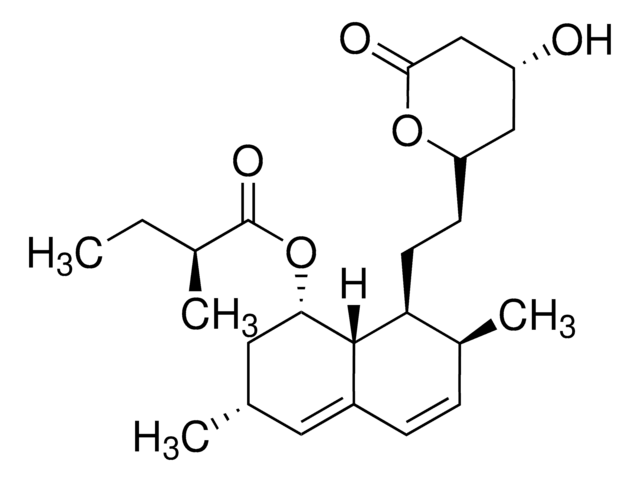586005
Thapsigargin
≥97% (TLC), solid, endoplasmic reticular Ca2+-ATPase inhibitor, Calbiochem®
Synonym(s):
Thapsigargin - CAS 67526-95-8 - Calbiochem
About This Item
Recommended Products
product name
Thapsigargin - CAS 67526-95-8 - Calbiochem, Thapsigargin, CAS 67526-95-8, is a cell-permeable, tumor-promoting sesquiterpene lactone that releases calcium by non-competitvley inhibiting endoplasmic reticular Ca2+-ATPase (IC₅₀ = 4-13 nM).
Quality Level
Assay
≥97% (TLC)
form
solid
manufacturer/tradename
Calbiochem®
storage condition
OK to freeze
protect from light
color
colorless
solubility
DMSO: >1 mg/mL
ethanol: 5 mg/mL
shipped in
ambient
storage temp.
−20°C
InChI
1S/C34H50O12/c1-9-12-13-14-15-17-24(37)43-28-26-25(20(5)27(28)44-30(38)19(4)11-3)29-34(41,33(8,40)31(39)45-29)22(42-23(36)16-10-2)18-32(26,7)46-21(6)35/h11,22,26-29,40-41H,9-10,12-18H2,1-8H3/b19-11-/t22-,26+,27-,28-,29-,32-,33+,34+/m0/s1
InChI key
IXFPJGBNCFXKPI-FSIHEZPISA-N
General description
Biochem/physiol Actions
endoplasmic reticular Ca2+ ATPase
Warning
Reconstitution
Other Notes
Won, J.G. and Orth, D.N. 1995. Endocrinology 136, 5399.
Tepel, M., et al. 1994. Biochim. Biophys. Acta1220, 248.
Begum, N., et al. 1993. J. Biol. Chem. 268, 3352.
Low, A.M., et al. 1993. Eur. J. Pharmacol.230, 53.
Tsukamoto, A. and Karneko, Y. 1993. Cell. Biol. Int.17, 969.
Wong, W.L., et al. 1993. Biochem. J.289, 71.
Glennon, M.C., et al. 1992. J. Biol. Chem. 267, 25568.
Xu, Y., et al. 1992. J. Neurochem.59, 2224.
Mason, M.J., et al. 1991. J. Biol. Chem. 266, 20856.
Thastrup, O., et al. 1990. Proc. Natl. Acad. Sci. USA87, 2466.
Legal Information
Signal Word
Danger
Hazard Statements
Precautionary Statements
Hazard Classifications
Eye Irrit. 2 - Resp. Sens. 1 - Skin Irrit. 2 - STOT SE 3
Target Organs
Respiratory system
Storage Class Code
11 - Combustible Solids
WGK
WGK 3
Flash Point(F)
Not applicable
Flash Point(C)
Not applicable
Certificates of Analysis (COA)
Search for Certificates of Analysis (COA) by entering the products Lot/Batch Number. Lot and Batch Numbers can be found on a product’s label following the words ‘Lot’ or ‘Batch’.
Already Own This Product?
Find documentation for the products that you have recently purchased in the Document Library.
Customers Also Viewed
Our team of scientists has experience in all areas of research including Life Science, Material Science, Chemical Synthesis, Chromatography, Analytical and many others.
Contact Technical Service


